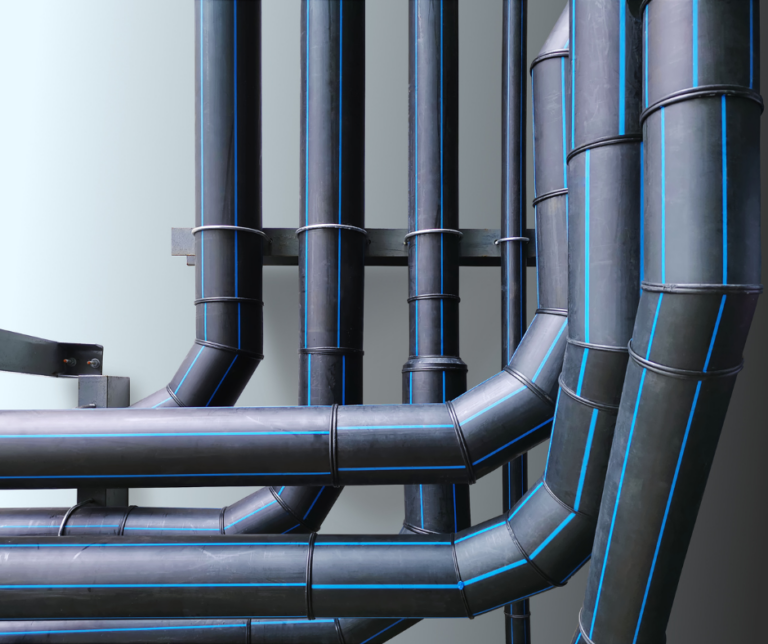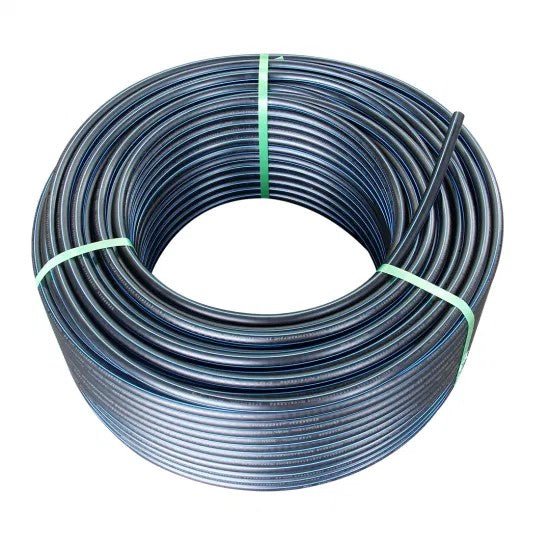custom hdpe pipe manufacturing Midland TX: Breakthroughs Shaping the Market
Discover the Production Process Behind High-Quality HDPE Pipeline and Its Applications
The production process of top quality HDPE pipelines is complex and systematic. It starts with the choice of raw products that enhance efficiency. Following this, ethylene goes through polymerization to create resin, which is after that shaped via extrusion. Quality assurance is vital, making sure that the last item satisfies strict criteria. Nevertheless, the trip of HDPE pipes does not finish with production. Their applications throughout different markets reveal a wider relevance worth checking out.
Comprehending HDPE: Properties and Advantages

High-density polyethylene (HDPE) is a functional polycarbonate understood for its durability and resistance to different environmental aspects. This material exhibits superb tensile stamina, making it suitable for demanding applications. Its low-density framework contributes to a light-weight item, promoting simplicity of taking care of and installment. HDPE additionally showcases impressive resistance to chemicals, which reduces degradation when subjected to rough materials.
The product's reduced dampness absorption better enhances its longevity, making it perfect for use in pipes and storage containers. Additionally, HDPE is resistant to ultraviolet (UV) radiation, ensuring that items preserve their integrity even when exposed to sunlight. Additionally, its adaptability enables for the creation of detailed forms without compromising stamina. The green nature of HDPE, often derived from recycled materials, includes in its charm, promoting sustainable practices in production. In general, these residential or commercial properties and benefits make HDPE a preferred option for various commercial and consumer applications.
Raw Material Choice for HDPE Production
The selection of raw materials for HDPE production is essential to confirm the end product fulfills the desired specifications and high quality criteria. High-density polyethylene (HDPE) is mainly produced from polymerized ethylene, stemmed from nonrenewable fuel sources such as gas or petroleum. The top quality of these feedstocks significantly affects the mechanical and thermal residential or commercial properties of the final HDPE.
Ingredients likewise play a significant function in improving HDPE's efficiency, consisting of antioxidants, UV stabilizers, and colorants, which boost sturdiness and resistance to environmental elements. The selection process must consider not just the chemical structure of the raw products however likewise their handling features to guarantee efficient production.
The sourcing of raw materials ought to prioritize sustainability and conformity with ecological regulations, as responsible practices are essential in today's market. Inevitably, mindful resources selection lays the foundation for creating high-grade HDPE pipes appropriate for diverse applications.
The Extrusion Process: Forming HDPE Pipeline
The extrusion procedure plays a crucial duty fit HDPE pipes, starting with meticulous product prep work techniques that guarantee suitable flow and consistency. Similarly important is the style of the die, which straight affects the final dimensions and surface area quality of the pipe. Together, these factors add greatly to the effectiveness and high quality of HDPE pipeline manufacturing.
Material Prep Work Methods
Reliable manufacturing of HDPE pipes begins with careful product prep work methods, especially the extrusion process. During this phase, high-density polyethylene resin is initial dried to get rid of dampness, guaranteeing excellent circulation qualities. The material is then fed into the extruder, where it undergoes home heating and melting, transforming right into a viscous state. This home heating procedure is very carefully managed to maintain the material's stability and efficiency. The liquified HDPE is forced with a die, shaping it into a continual pipe kind. Appropriate temperature level management during extrusion is important, as it directly affects the product's properties and the final item quality. Once formed, the HDPE pipe is cooled down and reduced to specified sizes, ready for subsequent processing and applications.
Die Design Importance
Accuracy in die style plays a necessary function in the extrusion process of HDPE pipes. The die acts as the final shaping device, directly affecting the pipeline's dimensions, wall surface thickness, and surface finish. A properly designed die assurances uniform material flow, decreasing problems such as abnormalities and weak places. The geometry of the die should be maximized to accommodate the details properties of HDPE, including its thickness and thermal actions during extrusion. Furthermore, the cooling price of the product as it passes via the die can substantially influence the pipe's structural honesty. Subsequently, buying sophisticated die modern technology is essential for makers intending to create top quality HDPE pipes that fulfill industry criteria and client assumptions.
Quality Control Procedures in HDPE Production
Numerous elements affect the top quality of HDPE pipe production, reliable quality control procedures are essential to ensure uniformity and integrity in the last item (American Plastics HDPE Pipe for Oilfield). Key quality assurance techniques include strenuous product assessment, verifying that the raw polyethylene fulfills recognized standards for purity and density. Throughout the extrusion process, criteria such as temperature, pressure, and cooling time are carefully kept track of to preserve dimensional precision and architectural stability
On top of that, post-production testing is important; suppliers commonly carry out hydrostatic examinations to analyze the pipeline's stamina and resistance to stress. Visual examinations for surface area problems additionally boost quality control. Accreditation from relevant criteria organizations, like ASTM or ISO, supplies an extra layer of trustworthiness. By implementing these thorough quality assurance steps, producers can reduce issues, enhance efficiency, and guarantee that the HDPE pipelines satisfy the details demands of different applications, ultimately bring about customer fulfillment and count on the item.
Applications of HDPE Pipeline Throughout Industries
HDPE pipes are used across numerous industries as a result of their durability and versatility. In water distribution systems, they guarantee efficient delivery, while in wastewater administration, they give reputable services for waste transportation. In addition, farming watering networks benefit from HDPE's resistance to deterioration and adaptability, making it a suitable option for contemporary farming practices.

Water Circulation Equipments
A substantial variety of industries count on high-density polyethylene (HDPE) pipelines for effective water distribution systems. Known for their longevity and resistance to corrosion, HDPE pipelines are widely utilized in metropolitan water networks, agricultural watering, and commercial applications. Their lightweight nature helps with easy handling and installment, lowering labor costs and time. Furthermore, HDPE pipelines can suit various pressure levels, making them ideal for both reduced and high-pressure systems. hdpe pipe suppliers Midland TX. The versatility of the product enables for smooth assimilation right into existing facilities, decreasing the need for comprehensive excavation. HDPE's resistance to chemical leaching guarantees that the water provided remains safe and clean, making it an optimal choice for preserving the high quality of drinkable water throughout numerous fields.
Wastewater Monitoring Solutions
Effective water distribution systems also pave the means for innovative wastewater administration services, where high-density polyethylene (HDPE) pipelines play a significant duty. Distinguished for their toughness and resistance to deterioration, HDPE pipes are suitable for transporting wastewater in different settings. Their versatility permits easy setup in complex settings, minimizing the requirement for considerable excavation. Furthermore, HDPE's smooth indoor surface reduces rubbing, improving flow prices and performance. These pipelines are likewise resistant to chemical leaching, ensuring that pollutants do not compromise the surrounding atmosphere. Industries, towns, and treatment centers progressively rely on HDPE pipes for their reliability and durability, making them a recommended selection for modern-day wastewater management systems. This adaptability highlights the critical importance of HDPE pipelines across many applications.
Agricultural Irrigation Networks
Agricultural watering networks benefit greatly from using high-density polyethylene (HDPE) pipes, which supply efficient and trusted water delivery to crops. HDPE pipelines are light-weight, making them simple to move and set up, while their versatility permits for numerous arrangements in diverse terrains. These pipelines demonstrate outstanding resistance to rust, chemicals, and UV radiation, making sure resilience in harsh agricultural atmospheres. Additionally, their smooth interior surface area decreases friction loss, enhancing water flow and lowering energy costs connected with pumping. The durability of HDPE pipes, typically going beyond half a century, adds to lower upkeep and substitute costs. Subsequently, farmers progressively rely upon HDPE pipelines to boost watering performance and promote lasting farming methods, inevitably leading to enhanced crop yields and source conservation.
Future Fads in HDPE Pipeline Technology
As the demand for lasting and effective infrastructure grows, advancements in HDPE pipe technology are positioned to change different sectors. Arising patterns include the assimilation of clever technologies, such as sensors and IoT capabilities, which assist in real-time monitoring of pipeline problems, decreasing upkeep expenses and protecting against leaks. In addition, the growth of advanced production techniques, such as 3D printing, is allowing the production of complex, tailored pipeline styles that deal with certain project requirements.
The emphasis on recycling and circular economic climate practices is driving the advancement of HDPE pipes made from recycled products, boosting sustainability. Enhanced jointing approaches, such as electro-fusion and mechanical installations, are also boosting installment performance and reliability. The expanding emphasis on ecological guidelines is pushing makers to take on greener production procedures, guaranteeing that HDPE pipes not only meet industry criteria however additionally foster a more sustainable future for facilities advancement.
Regularly Asked Concerns
Just How Does HDPE Compare to Other Plastic Products?
HDPE outperforms numerous various other plastic products relating to durability, chemical resistance, and versatility. Its low thickness and high tensile stamina make it suitable for different applications, frequently surpassing options in both efficiency and durability.
What Are the Environmental Impacts of HDPE Manufacturing?
The ecological influences of HDPE manufacturing consist of greenhouse gas emissions, power usage, and potential contamination from producing procedures. Additionally, inappropriate disposal can cause soil and water contamination, elevating concerns regarding long-lasting environmental effects.
Can HDPE Pipes Be Recycled?
Yes, HDPE pipes can be reused. Several centers approve utilized HDPE for processing, transforming it right into brand-new products. This reusing adds to sustainability efforts, reducing plastic waste while preserving sources and power in the manufacturing cycle.
What Is the Life Expectancy of HDPE Piping?

Just How Do Temperature Level Variants Affect HDPE Pipe Efficiency?
Temperature level variations significantly impact HDPE pipeline efficiency, impacting versatility and toughness. Heats can cause softening, while low temperature levels check here may create brittleness, eventually affecting the pipeline's sturdiness and viability for different applications in diverse environments.